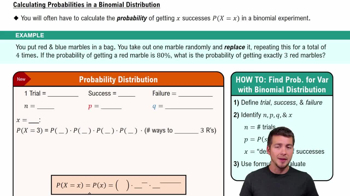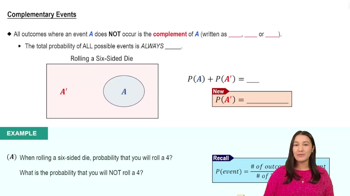Acrophobia USA Today reported results from a survey in which subjects were asked if they are afraid of heights in tall buildings. The results are summarized in the accompanying table. Does this table describe a probability distribution? Why or why not?
Table of contents
- 1. Intro to Stats and Collecting Data1h 14m
- 2. Describing Data with Tables and Graphs1h 55m
- 3. Describing Data Numerically2h 5m
- 4. Probability2h 16m
- 5. Binomial Distribution & Discrete Random Variables3h 6m
- 6. Normal Distribution and Continuous Random Variables2h 11m
- 7. Sampling Distributions & Confidence Intervals: Mean3h 23m
- Sampling Distribution of the Sample Mean and Central Limit Theorem19m
- Distribution of Sample Mean - Excel23m
- Introduction to Confidence Intervals15m
- Confidence Intervals for Population Mean1h 18m
- Determining the Minimum Sample Size Required12m
- Finding Probabilities and T Critical Values - Excel28m
- Confidence Intervals for Population Means - Excel25m
- 8. Sampling Distributions & Confidence Intervals: Proportion1h 12m
- 9. Hypothesis Testing for One Sample3h 29m
- 10. Hypothesis Testing for Two Samples4h 50m
- Two Proportions1h 13m
- Two Proportions Hypothesis Test - Excel28m
- Two Means - Unknown, Unequal Variance1h 3m
- Two Means - Unknown Variances Hypothesis Test - Excel12m
- Two Means - Unknown, Equal Variance15m
- Two Means - Unknown, Equal Variances Hypothesis Test - Excel9m
- Two Means - Known Variance12m
- Two Means - Sigma Known Hypothesis Test - Excel21m
- Two Means - Matched Pairs (Dependent Samples)42m
- Matched Pairs Hypothesis Test - Excel12m
- 11. Correlation1h 6m
- 12. Regression1h 50m
- 13. Chi-Square Tests & Goodness of Fit1h 57m
- 14. ANOVA1h 57m
5. Binomial Distribution & Discrete Random Variables
Binomial Distribution
Problem 5.2.28c
Textbook Question
In Exercises 25–28, find the probabilities and answer the questions.
Too Young to Tat Based on a Harris poll, among adults who regret getting tattoos, 20% say that they were too young when they got their tattoos. Assume that five adults who regret getting tattoos are randomly selected, and find the indicated probability.
c. Find the probability that the number of selected adults saying they were too young is 0 or 1.
 Verified step by step guidance
Verified step by step guidance1
Step 1: Recognize that this is a binomial probability problem. The problem involves a fixed number of trials (n = 5), two possible outcomes (saying they were too young or not), and a constant probability of success (p = 0.20). The binomial probability formula is P(X = k) = (n choose k) * p^k * (1-p)^(n-k), where k is the number of successes.
Step 2: To find the probability that the number of selected adults saying they were too young is 0 or 1, calculate P(X = 0) and P(X = 1) separately using the binomial probability formula.
Step 3: For P(X = 0), substitute k = 0, n = 5, and p = 0.20 into the formula: P(X = 0) = (5 choose 0) * (0.20)^0 * (1-0.20)^5. Simplify the expression to compute the probability.
Step 4: For P(X = 1), substitute k = 1, n = 5, and p = 0.20 into the formula: P(X = 1) = (5 choose 1) * (0.20)^1 * (1-0.20)^4. Simplify the expression to compute the probability.
Step 5: Add the probabilities from Step 3 and Step 4 to find the total probability: P(X = 0 or X = 1) = P(X = 0) + P(X = 1). This is the final result.
 Verified video answer for a similar problem:
Verified video answer for a similar problem:This video solution was recommended by our tutors as helpful for the problem above
Video duration:
3mPlay a video:
Was this helpful?
Key Concepts
Here are the essential concepts you must grasp in order to answer the question correctly.
Binomial Probability
Binomial probability refers to the likelihood of a specific number of successes in a fixed number of independent Bernoulli trials, each with the same probability of success. In this context, the 'success' is defined as an adult saying they were too young when they got their tattoo, with a success probability of 20%. The binomial formula is used to calculate the probability of obtaining a certain number of successes (0 or 1 in this case) out of the total trials (5 adults).
Recommended video:
Guided course

Calculating Probabilities in a Binomial Distribution
Probability Distribution
A probability distribution describes how the probabilities are distributed over the values of a random variable. For a binomial distribution, it provides the probabilities of obtaining 0, 1, 2, ..., n successes in n trials. Understanding this distribution is crucial for calculating the probabilities of specific outcomes, such as the number of adults who regret their tattoos due to being too young.
Recommended video:
Guided course

Calculating Probabilities in a Binomial Distribution
Complement Rule
The complement rule in probability states that the probability of an event occurring is equal to 1 minus the probability of it not occurring. This concept is useful when calculating probabilities for multiple outcomes, such as finding the probability of 0 or 1 adults saying they were too young. By understanding the complement, one can simplify calculations by focusing on the opposite outcomes.
Recommended video:

Complementary Events

 6:00m
6:00mWatch next
Master The Binomial Experiment with a bite sized video explanation from Patrick
Start learningRelated Videos
Related Practice
Textbook Question
